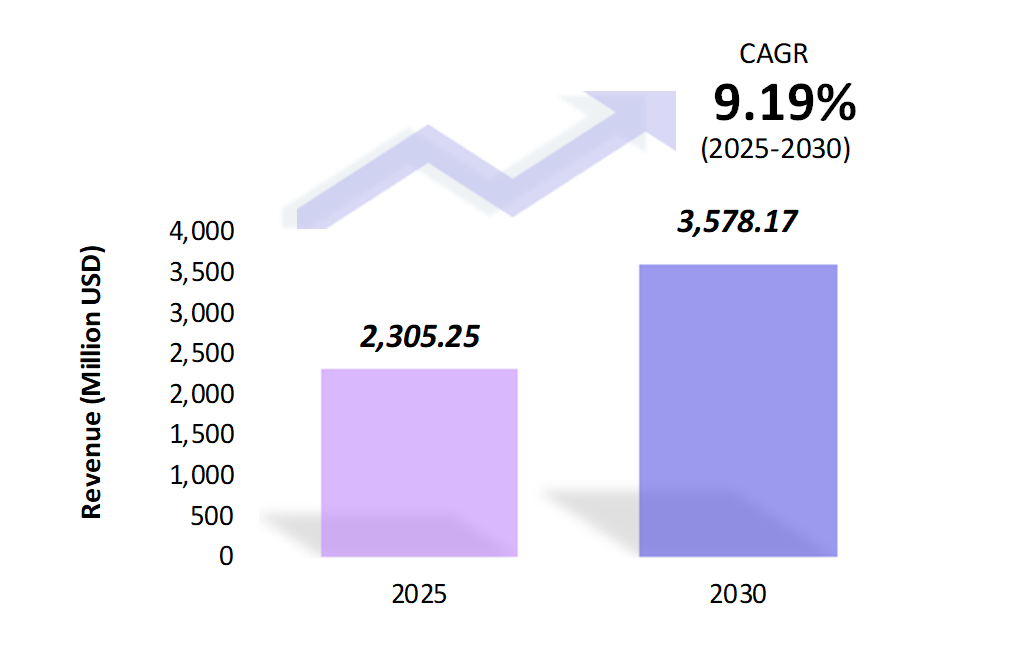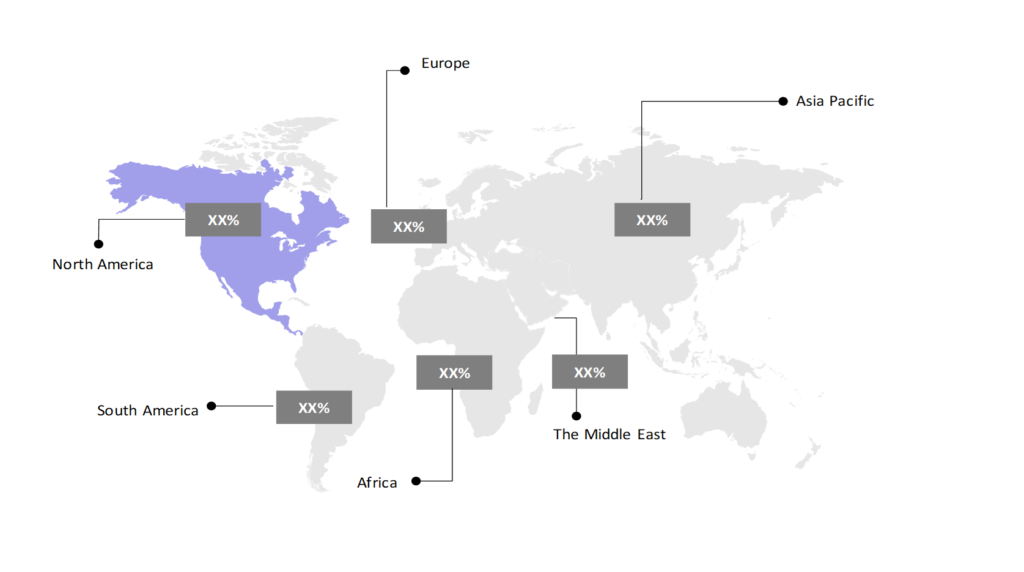Remote Operated Vehicle (ROV) Market Outlook: Size, Share, Trends & Growth Analysis (2024-2029)
The market report presents a thorough analysis segmented by Type (Work Class ROV, Observatory Class ROV, Others); by Application (Oil and Gas, Defense, Deep Sea Marine Exploration, Others); by Geography (North America, South America, Asia Pacific, Europe, The Middle East, Africa).
Outlook

- The remote-operated vehicle (ROV) market is estimated to be USD 2,305.25 Mn in 2025 and is anticipated to reach USD 3,578.17 Mn in 2030.
- The remote-operated vehicle (ROV) market is registering a CAGR of 9.19% during the forecast period 2025-2030.
- The remote-operated vehicle (ROV) market is poised for sustained growth due to increasing applications across various industries, including oil and gas, renewable energy, and marine research. Technological advancements, such as Artificial Intelligence-driven autonomous capabilities and compact ROV designs, are expanding the market’s potential.
Request a free sample.
Ecosystem

- The participants in the global remote-operated vehicle (ROV) industry are always developing their strategies to preserve a competitive advantage.
- These companies primarily use acquisitions, research & developments, partnerships, and technological launches.
- Several important remote-operated vehicle (ROV) market entities include DeepOcean Group; DOF Subsea AS; Oceaneering International, Inc.; TechnipFMC Plc; Helix Energy Solutions Group, Inc.; and others.
Ask for customization.
Findings
| Attributes | Values |
|---|---|
| Historical Period | 2019-2023 |
| Base Year | 2024 |
| Forecast Period | 2025-2030 |
| Market Size (2025) | USD 2,305.25 Mn |
| Market Size (2030) | USD 3,578.17 Mn |
| Growth Rate | 9.19% CAGR from 2025 to 2030 |
| Key Segments | Type (Work Class ROV, Observatory Class ROV, Others); Application (Oil and Gas, Defense, Deep Sea Marine Exploration, Others); Geography (North America, South America, Asia Pacific, Europe, The Middle East, Africa) |
| Key Vendors | DeepOcean Group; DOF Subsea AS; Oceaneering International, Inc.; TechnipFMC Plc; Helix Energy Solutions Group, Inc. |
| Key Countries | The US; Canada; Mexico; Brazil; Argentina; Colombia; China; India; Japan; The UK; Germany; Norway; UAE; Saudi Arabia; Egypt; South Africa |
| Largest Market | North America |
Get a free quote.
Trends
- Advances in Autonomous and Hybrid ROVs: The integration of autonomous capabilities in ROVs, such as AI-driven navigation and sensor integration, is enabling more efficient and longer missions. For instance, in 2022, Saab Seaeye introduced the Sabertooth, a hybrid ROV with autonomous capabilities that allow for greater operational range and depth, appealing to deep-sea exploration and defense applications.
- Technological Advancements in ROV Components: Advancements in cameras, sensors, and manipulators have significantly improved the capabilities of remotely operated vehicles (ROVs). These innovations enable ROVs to capture high-resolution images and videos, navigate more precisely, and perform more complex tasks in challenging underwater environments. As a result, ROVs are now more effective in applications like deep-sea exploration, underwater construction, and maintenance. In 2023, Teledyne Marine introduced a range of high-definition underwater cameras for ROVs, enabling better data collection and improving the quality of inspections.
- Use of AI and Data Analytics for ROV Operations: Artificial intelligence and data analytics integration in ROV operations help operators process large volumes of data collected during underwater missions, enhancing efficiency and safety. In 2023, Oceaneering International introduced an AI-based data analytics platform for its ROV services, allowing for real-time insights and predictive maintenance capabilities.
Speak to analyst.
Catalysts
- Expanding Offshore Oil and Gas Exploration: The growing demand for oil and gas, particularly from deepwater reserves, is fueling the need for ROVs in subsea operations. These vehicles play a crucial role in tasks like inspection, maintenance, and repair, helping to enhance safety and reduce operational costs in challenging underwater environments. ROVs enable more efficient and precise work, minimizing the risks and downtime associated with deepwater oil and gas extraction.
- Growth in Environmental and Oceanographic Research: The growing emphasis on environmental monitoring and marine conservation drives the increased adoption of remotely operated vehicles (ROVs) in oceanographic research. As concerns over biodiversity loss and the health of coral reefs intensify, ROVs are becoming essential tools for conducting in-depth studies and real-time monitoring of marine ecosystems. Their ability to operate in challenging underwater environments makes them invaluable for advancing marine science, creating significant market demand for ROV technology in research and conservation applications. This shift is expected to fuel further innovation and growth in the ROV market.
- Government Funding and Marine Research Projects: Increased government investment in oceanographic research and marine ecosystem preservation is driving the demand for remotely operated vehicles (ROVs). In 2023, the US government allocated funding to the National Oceanic and Atmospheric Administration (NOAA) to support marine research initiatives, including the expansion of ROV deployments for seabed exploration and ecosystem monitoring. This growing governmental support is fueling the adoption of ROV technology, positioning it as a key tool in advancing marine science and conservation efforts.
Inquire before buying.
Restraints
- High Cost of ROV Systems and Maintenance: ROV technology remains costly, limiting access for smaller organizations and some research institutions. Maintenance is also challenging due to complex components requiring skilled technicians. For example, an ROV system with advanced capabilities can cost upwards of USD 1 million, creating entry barriers for smaller operators.
- Technical Challenges in Deep-Water Operations: A market challenge for remotely operated vehicles (ROVs) is the harsh conditions of deep-sea environments, including extreme pressure, low temperatures, and complete darkness. These factors compromise ROV performance, requiring advanced engineering and specialized materials to ensure reliability and functionality. As deep-sea exploration and ecosystem monitoring grow, manufacturers face the ongoing challenge of developing ROVs capable of operating in these extreme conditions, which drives both technological innovation and cost considerations in the market.
- Supply Chain Disruptions: A significant market challenge for the ROV industry is the vulnerability of the global supply chain for electronic components, which has impacted production timelines. In 2022, companies like Subsea 7 experienced delays in ROV deliveries due to critical parts shortages, such as microchips. These supply chain disruptions have led to extended service timelines and increased costs, hindering market growth.
Personalize this research.
Hotspot

Explore purchase options.
Table of Contents
| 1. Introduction 1.1. Research Methodology 1.2. Scope of the Study 2. Market Overview / Executive Summary 2.1. Global Remote Operated Vehicle (ROV) Market (2019 – 2023) 2.2. Global Remote Operated Vehicle (ROV) Market (2024 – 2030) 3. Market Segmentation 3.1. Global Remote Operated Vehicle (ROV) Market by Type 3.1.1. Work Class ROV 3.1.2. Observatory Class ROV 3.1.3. Others 3.2. Global Remote Operated Vehicle (ROV) Market by Application 3.2.1. Oil and Gas 3.2.2. Defense 3.2.3. Deep Sea Marine Exploration 3.2.4. Others 4. Regional Segmentation 4.1. North America 4.1.1. The US 4.1.2. Canada 4.1.3. Mexico 4.2. South America 4.2.1. Brazil 4.2.2. Argentina 4.2.3. Colombia 4.2.4. Rest of South America 4.3. Asia Pacific 4.3.1. China 4.3.2. India 4.3.3. Japan 4.3.4. Rest of Asia Pacific 4.4. Europe 4.4.1. The UK 4.4.2. Germany 4.4.3. Norway 4.4.4. Rest of Europe 4.5. The Middle East 4.5.1. UAE 4.5.2. Saudi Arabia 4.5.3. Rest of the Middle East 4.6. Africa 4.6.1. Egypt 4.6.2. South Africa 4.6.3. Rest of Africa 5. Value Chain Analysis of the Global Remote Operated Vehicle (ROV) Market 6. Porter Five Forces Analysis 6.1. Threats of New Entrants 6.2. Threats of Substitutes 6.3. Bargaining Power of Buyers 6.4. Bargaining Power of Suppliers 6.5. Competition in the Industry 7. Trends, Drivers and Challenges Analysis 7.1. Market Trends 7.1.1. Market Trend 1 7.1.2. Market Trend 2 7.1.3. Market Trend 3 7.2. Market Drivers 7.2.1. Market Driver 1 7.2.2. Market Driver 2 7.2.3. Market Driver 3 7.3. Market Challenges 7.3.1. Market Challenge 1 7.3.2. Market Challenge 2 7.3.3. Market Challenge 3 8. Opportunities Analysis 8.1. Market Opportunity 1 8.2. Market Opportunity 2 8.3. Market Opportunity 3 9. Competitive Landscape 9.1. DeepOcean Group 9.2. DOF Subsea AS 9.3. Oceaneering International, Inc. 9.4. TechnipFMC Plc 9.5. Helix Energy Solutions Group, Inc. 9.6. Company 6 9.7. Company 7 9.8. Company 8 9.9. Company 9 9.10. Company 10 |
Know the research methodology.
Remote Operated Vehicle (ROV) Market – FAQs
1. What is the current size of the remote operated vehicle (ROV) market?
Ans. In 2025, the remote operated vehicle (ROV) market size is USD 2,305.25 Mn.
2. Who are the major vendors in the remote operated vehicle (ROV) market?
Ans. The major vendors in the remote operated vehicle (ROV) market are DeepOcean Group; DOF Subsea AS; Oceaneering International, Inc.; TechnipFMC Plc; Helix Energy Solutions Group, Inc.
3. Which segments are covered under the remote operated vehicle (ROV) market segments analysis?
Ans. The remote operated vehicle (ROV) market report offers in-depth insights into Type, Application, and Geography.
